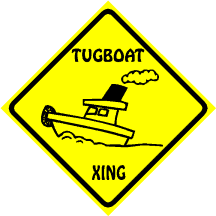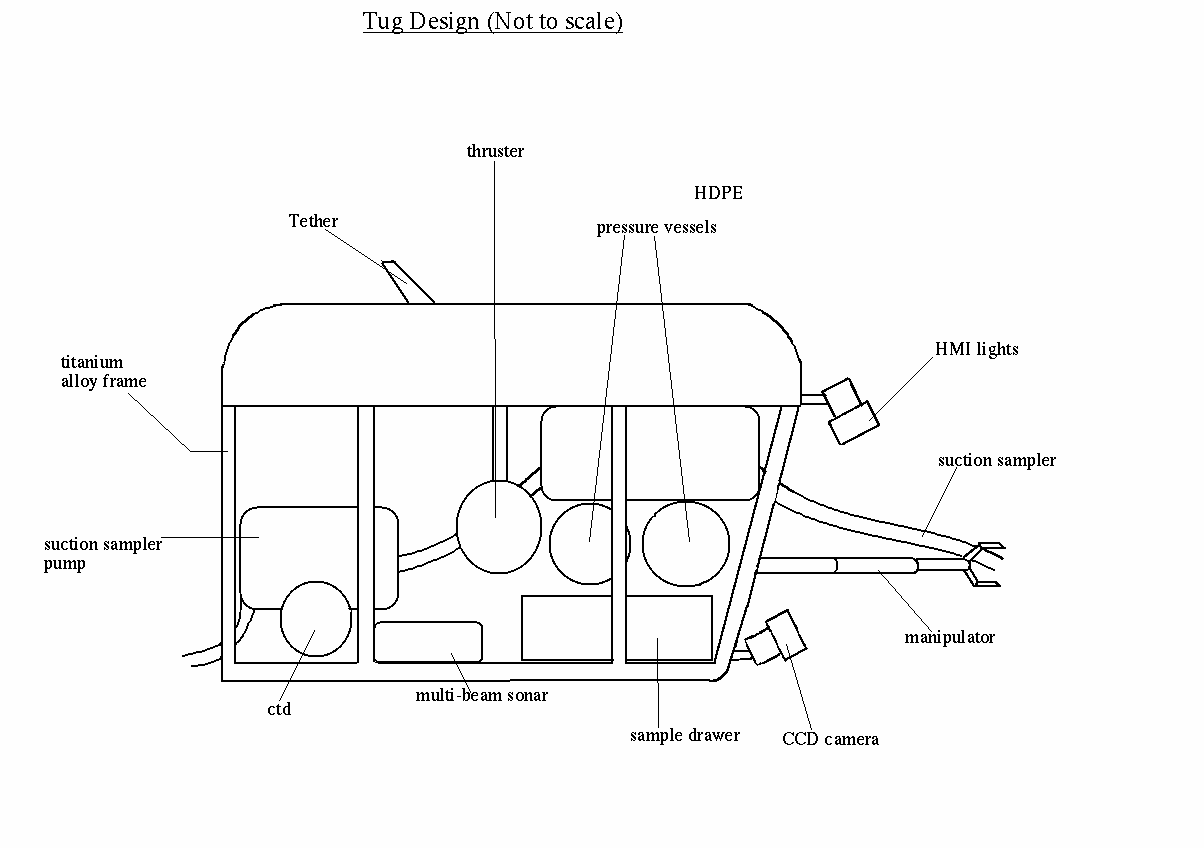Tug ROV

Tug is a Remotely Operated Vehicle (ROV) who operates via a tether connected to the Manned Vehicle. ROV's are distinguished by their tether, which traditionally gives the vessel access to (almost) infinite power and with fiber optics allows communication with people. In addition to carrying tools and sensors to depict the environment around it, Tug's real-time communication with scientists gives him higher precision and more relevant actions. If there's something interesting the viewers see Tug come across, they can ask him to take additional pictures and measurements, exploring the area in more detail than he would have otherwise done. As it is impossible to plan for all the possible situations, the tether allows flexibility of action.
In thinking about this advantageous tether, one finds that running a cable all the way to the habitat where the scientist labs and living quarters are is extremely difficult. It is important that Tug is able to explore vents within a few kilometer radius from the habitat, but having such a long cable creates many complications. First, currents make it difficult to control the cable and keep it in place. It is also important that the cable not drag along the seafloor and damage the life and geology the scientists are there to study. Further, a cable that is a few miles long requires a vehicle with huge propulsion capabilities because it takes so much power to drag its entire mass. Ultimately, one realizes the utility of bringing the scientists with us - attach Tug's cable to the Manned Vehicle!
Technical Specifications
Dimensions = H*L*w = 0.6 m * 0.70 * 0.65 m
Depth rating = 5 000m
Tug is an ROV, and in his design is a tried and tested frame structure, where a titanium alloy frame (bonded with a layer of Ni-base alloy),is used to provide structural support and the components are attached to it.
An important consideration in the design of the ROV is to separate the center of buoyancy and the center of gravity to confer stability to the vehicle. This is achieved by packing the top of the ROV with syntactic foam, and keeping the motors, and heavy sonars at the bottom of the ROV. (See Navigation)

Click to see full sized Tug design
Sensors and Sonars
- CTD
- Multi-beam sonar
- Obstacle avoidance
- Acoustic doppler velocity log
Tools
- 3 * lights( 1 is a strobe, 2 are HMI lights)
- 2 * CCD color cameras
- 1 SIT black and white camera
- two 4 function manipulator
- Suction sampler
- Sample Drawer ( 0.4m*06m*15cm)
Electronics are housed in titanium alloy cylinder( with rounded ends).
Click for more details about Tools
Propulsion
Propulsion is supplied via 2 longitudinal thrusters, one lateral thruster and one vertical.Cable
Tug is connected to the manned vehicle via maximum ten meter cable. Cables are a very important aspect of ROV design. The tether serves three purposes:*It provides electrical power to the ROV. Therefore, it must have low resistance conducting wires, and be surrounded by an insulating material.
It provides a communication link between the manned vehicle and the ROV. The information passageways are usually optical fibers.
*It supports the ROV, and any objects in its payload. hence it must include a strength member.
*When using a tether one must also consider the drag on the cable itself. This is given by the equation:
Drag = 0.5 * p * A * V^2 * Cdrag
Drag is reduced by keeping the diamter of the cable to a minimum.
A tether management system is not needed in the design, because Tug is attached directly to the Manned Vehicle. Our tether will consist of:
Fiber optic cables for data transmission.
Multi-strand aluminum conductors
Insulation material polyurethane.
The tether will be neutrally buoyant. On board the manned vehicle there will be small hydraulic winch that will control the cable. The telemetry system will consist of up to five channels for different vehicle cameras, and manipulator operation. The system multi-plexes the channels.
Umbilical diameter = 19mm
Buoyancy calculations
| Instrument | Weight in Air(kg) | Weight in water |
|---|---|---|
| CTD | 2.7 | 1.4 |
| multi-beam | 4 | 1.25 |
| ADCP | 9.1 | 2.7 |
| Modem | 11.1 | 3.95 |
| Thruster | 10.8 | 8 |
| Navigation and electronics | 2.4 | 2.4 |
| Titanium alloy pressure vessels | 5 | 4 |
| Titanium- nickel alloy frame | 8 | 6.2 |
| Sipper | 2.2 | 0.9 |
| Suction sampler | 1.1 | -1.65 |
| Manipulators | 1.8 | 1.0 |
| 3 cameras | 6.0 | 3.1 |
| 3 Lights | 9 | 5.4 |
| Buoyant ABS top | 30 | -30 |
| Syntactic foam | 5.4 | -8 |
Therefore = total weight in air = 108.6 kg
Total weight in water =0.65 kg. Therefore buoyancy is -0.65 kg. Syntactic foam can be added to compensate for this slight negative buoyancy, and render the vehicle neutral.
Power Budget
- CTD - 5 W
- Multi-beam sonar - 10W
- Acoustic Doppler Velocity Log - 3W
- Obstacle avoidance - 4W
- Navigation Systems - 5W
- Electronic components and Intel cpu( navigation computer available from Sonardyne):- 1 -3W
- Actuators = 5 W
- Cameras (CCD)- micro-Seacam -18W
- 3 lights - 600 W maximum
- Suction Sampler - 2 W
- 4 thrusters - 250 W (but it will not be moving continuously)
Resources
1. Tugboat Picture: http://www.nafts.com/hmpage.htm2. Tug Design: created by Tawanda Sieanda

